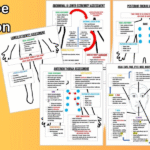The last four overs turn good innings into winning ones – or into a scoreboard that feels short by twelve. Bowlers arrive with plans drilled for months: full at the base of off, cutters into the pitch, fields that funnel you toward your weakest swing. Batters who keep scoring late do three things well. They live through the yorker, steal runs where the field forgets to look, and spot the slower ball early enough to adjust swing and shape. That’s a craft you can learn, not magic.
What the death actually asks of a batter
Across 16–20, the task is simple to say and hard to execute: raise your boundary rate without giving away cheap dots. That means striking the ball to areas with spare grass, accepting the single when the plan collapses, and guarding your stumps when the bowler hits the hole. You can’t bully every ball; you choose which ones to hit hard and which ones to nudge on purpose.
Live scores teach timing as much as they show totals. When you want to sanity-check pace of play or the value of a boundary vs. a two at a specific ground, open this website during a game window, note the fields, then come back to your notes. The idea is to train your eye to connect ball type, field, and outcome.
The final overs are about buying time for one clean swing per set. That means trimming risk on balls designed to choke you – true yorkers and well-hidden slower balls – and punishing the deliveries that drift: anything overpitched, anything short without shoulder, and anything with line that leaves you space behind the keeper or over the ring.
Yorker survival: geometry over bravado
A great yorker ends arguments. Your job isn’t to “dominate” it; your job is to survive it at a run-a-ball and keep the strike rotating until the seam slips by half an inch. Think geometry, not muscle.
Start neutral in the crease with the bat already low – heel skimming the ground. A high backlift gives you pretty pictures and late contact; a low start buys you millisecond margin. Open your front foot a fraction toward cover so the bat can come down straight. If you’re late, you’ll toe it; if you’re early, you’ll spike it up the pitch. Either is better than dead pads.
Where to stand? Up against the line on a bowler who misses full (to turn a yorker into a half-volley); deep on a bowler who nails the base (to turn a yorker into a length you can squeeze). You can move after release, but don’t try to be a magician: small, readable shuffles beat big, theatrical steps that invite the wide yorker.
Shot choice is humble and effective. The safest option is the drop-and-go: meet the ball, deaden the hands, and roll the wrists to third or leg with intent to run. Practice calling early and turning blind with trust. Boundaries come when the length spills even two ball-widths higher; then your same shape becomes a flat-bat through extra or midwicket. If the bowler follows your back-away with pace on, tuck in; a skidding yorker at the toes ruins egos and chases.
Cues that scream “yorker” show up: a late change to around the wicket for the wide hole, the keeper starting wider, fielders creeping square on the off side. When you read those signals, pre-load the drop-and-go and protect the base. Living through two balls keeps the over alive.
Ramp windows: when the field gives you sky
The ramp is a steal, not a statement. It exists because death fields often lock midwicket and long-off/long-on, then hide a third fielder deep square. That leaves the slice behind point and the space over the keeper. Your job is to decide before release whether the line will let you show the blade with control.
Good conditions: seamers angling wide at pace, fine leg up, third man square or too fine, keeper setting up on leg stump for the yorker outside off. If the ball is truly full and outside your reach, ramp is on. If the ball is at your hip or short with a sharp shoulder, it’s a top-edge lottery – leave it.
Mechanics should be boring. Small back-away to clear the hands, head still, eyes down, open face presented late. You’re guiding, not scooping. Think of it as a late cut that goes upward because the pace does the lifting. If you see the bowler take pace off, abort; the ramp dies without speed. Switch to a late dab into the third-man pocket and run hard. The ramp exists because bowlers get greedy with the wide hole; punish greed, not discipline.
Reading the slower ball without guessing
Slower balls are built to tempt your swing before the ball arrives. You don’t need to predict the type; you need to delay the hit until your eyes confirm the pace. That starts with hands soft and a base that can wait half a beat.
What to watch: wrist position that turns over early (back-of-the-hand), a wider-than-usual grip, a seam that wobbles across your view, and – most of all – arm speed that doesn’t match run-up. Many bowlers keep the arm fast but the shoulder relaxes; you feel the difference more than you see it. If you suspect off-pace, sink half a step deeper in the crease as the ball leaves the hand. Deeper contact shortens your swing and lets you hit under the ball rather than through thin air.
Target zones change with off-pace. Hitting across the line is fine if the ball sits; otherwise, look straight: long-off, sightscreen, long-on. Cross-seam cutters grip and stop on used decks; play them late, with the face a touch closed to keep the ball down. Don’t force elevation unless you’ve got the length; a flat, hard blow into a pocket is worth two and keeps you on strike.
A clue that saves wickets: keepers who creep up a stride between balls often signal a pattern of pace-off. When you see that, fight the urge to pre-commit. Let the ball show its truth, then move your contact point – later, straighter, calmer.
A one-over checklist you can run at the non-striker’s end
- Field scan in three beats: third/fine, square sweepers, long-off/long-on. You’re matching these to lines, not to hope.
- First ball as a read. If it’s the bowler’s best ball, bank a single and see the hand. If it’s loose, take your swing early in the over.
- Yorker plan set: deep vs. up; drop-and-go ready; guard base off with a low start.
- Ramp criteria fixed: pace on, fine up, width outside you. No pace, no ramp.
- Slower-ball cue in mind: arm speed mismatch, grip wide, keeper edging up – wait, then hit straight.
- Non-striker job: call shape, shout cues (“pace-off,” “wide hole”), and win one extra two by turning hard.
Closing notes
Death batting is less about miracle shots and more about picking the right fight. Survive the hole with quiet hands and small feet. Take the free sky only when the field and pace agree. Read the release, not the story in your head, and shift your contact point when the ball loses speed. Do those three things and your last four overs stop feeling like a coin toss. They become a set of repeatable moves you run under lights, in noise, with a plan you trust.



